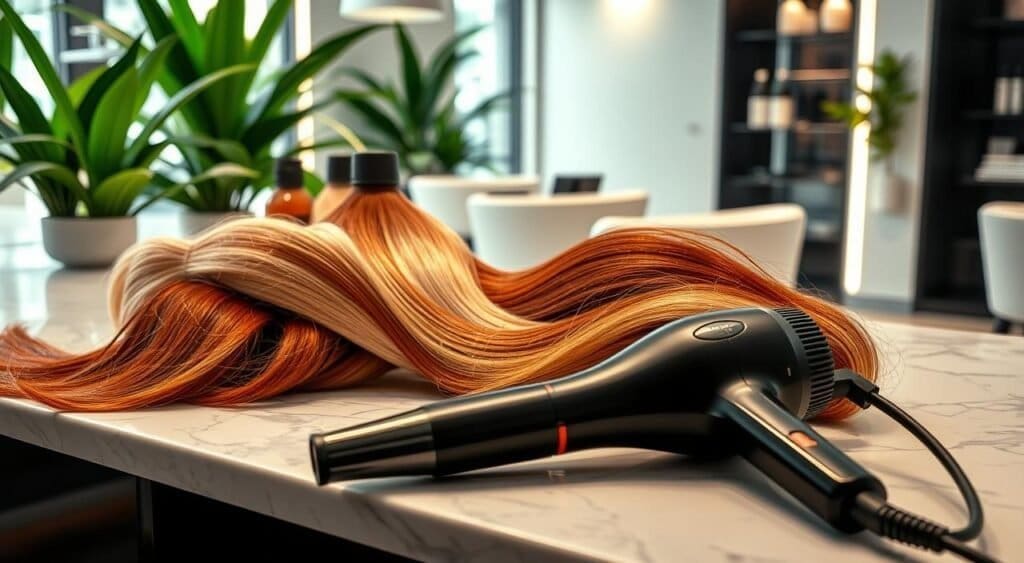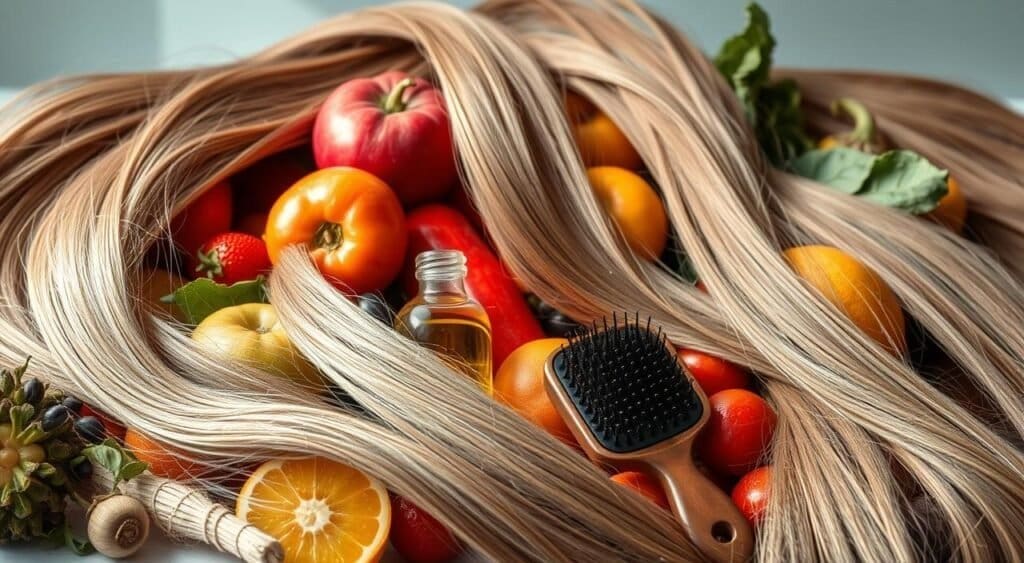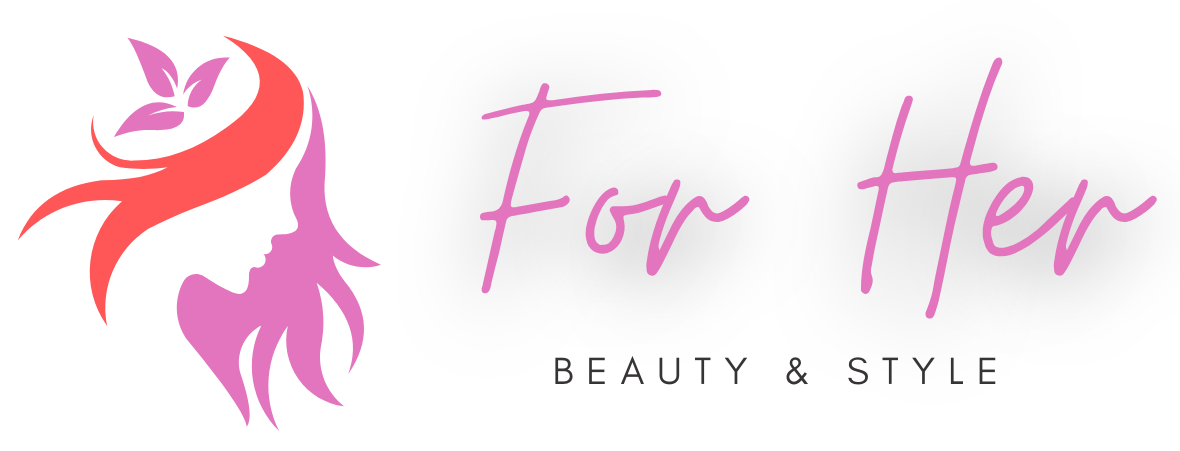Did you know that the average person’s hair grows approximately half an inch per month, resulting in a remarkable six inches of growth over the course of a year? While this statistic may seem impressive, maintaining the health and vibrancy of those luscious locks requires a comprehensive haircare routine. In this comprehensive guide, we’ll unveil the essential tips and techniques to help you achieve the healthy, beautiful hair of your dreams.
From proper washing and conditioning methods to the role of hair masks and treatments, this article covers all the crucial aspects of haircare. You’ll also learn about the significance of scalp care, the impact of heat styling, and the connection between diet and hair health. By the end, you’ll be equipped with the knowledge to transform your hair into a true crowning glory.
Key Takeaways
- Regular trims every 6-8 weeks help prevent split ends and promote healthy hair growth.
- Incorporating protein-rich foods such as eggs, fish, nuts, and beans can contribute to stronger and shinier hair.
- Using a clarifying shampoo once a month helps remove product buildup and excess oil to maintain hair shine.
- Proper hydration and the use of moisturizing hair products are vital for retaining hair moisture.
- Minimizing heat styling and opting for low-heat techniques can help maintain hair health and shine.
Understanding Your Hair Type
Identifying your unique hair type is the foundation for an effective haircare routine. Hair can be broadly classified into four main types based on curl pattern: straight, wavy, curly, and coily. These types are determined by the shape of the hair follicles and influenced by genetics.
Different Hair Types Explained
Straight hair (Type 1) has a flat, smooth texture with no defined curl pattern. Wavy hair (Type 2) features loose, S-shaped waves, further divided into subcategories 2A, 2B, and 2C based on wave tightness. Curly hair (Type 3) has well-defined, springy coils, ranging from loose 3A curls to tight 3C ringlets. Coily hair (Type 4) is characterized by tight, Z-shaped coils, with subtypes 4A, 4B, and 4C.
Many individuals have a combination of different hair types on various parts of their head, making personal identification crucial for customized haircare.
How to Determine Your Hair Type
- Examine the overall texture and curl pattern of your hair.
- Consider the thickness and density of individual strands.
- Assess your hair’s porosity, or ability to absorb and retain moisture.
- Observe your hair’s natural oil production, whether oily, dry, or a combination.
Online hair type quizzes and consultations with hair professionals can also help you accurately determine your unique hair type. Understanding this information empowers you to select the right products and techniques for your hair’s specific needs.
| Hair Type | Characteristics | Recommended GK Hair Products |
|---|---|---|
| Straight (Type 1) | Flat, smooth texture with no defined curl pattern | GK Hair Balancing Shampoo and Conditioner |
| Wavy (Type 2) | Loose, S-shaped waves | GK Hair Moisturizing Shampoo and Conditioner |
| Curly (Type 3) | Well-defined, springy coils | GK Hair CurlsDefineHer |
| Coily (Type 4) | Tight, Z-shaped coils | GK Hair Argan Oil Serum |
The Importance of a Good Haircare Routine
Maintaining a consistent haircare routine is crucial for achieving and preserving healthy, beautiful hair. Your hair care regimen should address both daily and weekly practices to ensure your locks remain nourished, protected, and resilient throughout the year.
Daily vs. Weekly Haircare Practices
Your daily haircare routine should focus on gentle cleansing, gentle brushing, and protecting your hair from environmental factors like UV rays and pollution. Overwashing with hot water can strip away natural oils, leading to an unhealthy scalp and dull, brittle hair. Instead, use warm water and consider rinsing with cool water at the end to seal the hair cuticle and enhance shine.
Weekly haircare practices should incorporate more intensive treatments, such as deep conditioning masks or intensive heat treatments. These can help to intensely hydrate, strengthen, and repair damaged hair. Applying treatment creams regularly can also contribute to softer, more manageable locks.
Tailoring Your Routine for Seasonal Changes
As the seasons change, your hair care routine should adapt to meet your hair’s evolving needs. During the dry, cold winter months, increased hydration is essential to prevent breakage and maintain suppleness. In the summer, extra protection from UV rays and humidity is crucial to avoid frizz and damage.
By customizing your haircare regimen to the unique demands of each season, you can ensure your hair remains healthy, vibrant, and resilient throughout the year. This proactive approach to haircare can boost your confidence and self-esteem, as the condition of your hair is closely tied to your overall appearance and well-being.
“88% of women believe that the condition of their hair is related to their self-confidence.”
Choosing the Right Shampoo and Conditioner
Selecting the appropriate shampoo and conditioner is crucial for maintaining healthy, beautiful hair. With a wide array of hair products and hair care ingredients available, it can be overwhelming to find the perfect match for your specific hair type and needs. Let’s explore the key differences between sulfate-free and regular shampoos, as well as the essential ingredients to look for when choosing your haircare routine.
Sulfate-Free vs. Regular Shampoo
Sulfate-free shampoos have gained popularity in recent years due to their gentler approach. Unlike regular shampoos, which can strip the hair of its natural oils, sulfate-free formulas are designed to preserve moisture and protect the hair’s health. They are particularly beneficial for those with dry, damaged, or color-treated hair, as they help maintain the hair’s natural oils and prevent excessive drying.
Key Ingredients to Look For
- Natural oils (e.g., argan, coconut, jojoba) for nourishment and hydration
- Proteins (e.g., keratin, collagen) to strengthen and fortify the hair
- Moisturizing agents like glycerin to lock in moisture
- Avoid harsh chemicals that can strip the hair of its natural oils
When selecting shampoo and conditioner, consider your specific hair type and concerns. Tailoring your haircare routine to your individual needs can make a significant difference in the health and appearance of your hair.
The Role of Hair Masks and Treatments
In the quest for healthy, beautiful hair, hair masks and deep conditioning treatments play a crucial role. These intensive hair care products provide targeted nourishment and repair, addressing common hair concerns like dryness, damage, and lack of shine. By deeply penetrating the hair shaft, hair masks and treatments help restore moisture, improve elasticity, and enhance overall hair health.
Benefits of Deep Conditioning
Regular use of hair masks and deep conditioning treatments can unlock a host of benefits for your tresses. These include increased shine, reduced frizz, and stronger, more resilient strands. The concentrated formula of hair masks helps to replenish essential nutrients and lock in moisture, leaving your hair feeling soft, manageable, and revitalized.
When to Use a Hair Mask
Hair masks are typically recommended for weekly or bi-weekly use, especially for individuals with dry, damaged, or chemically-processed hair. Products like the Batiste™ Leave-In Overnight Hair Mask offer a convenient, no-rinse option that allows for deep nourishment and repair while you sleep. By incorporating a high-quality hair mask into your routine, you can help prevent and address a range of hair concerns, ensuring your locks stay healthy and vibrant.
| Hair Mask Benefits | When to Use a Hair Mask |
|---|---|
|
|
“Incorporating a hair mask into your routine once or twice a week can lead to healthier, shinier, and more vibrant hair.”
Proper Hair Washing Techniques
Proper haircare techniques are essential for maintaining healthy, beautiful hair. The frequency of hair washing depends on your hair type, with most experts recommending 2-3 times per week for optimal results. Over-washing can strip natural oils, leading to dryness, while under-washing may cause buildup and greasiness.
How Often Should You Wash Your Hair?
The ideal hair washing frequency varies based on your hair type and lifestyle. Fine, oily hair may benefit from washing every other day, while thicker, coarser hair types can often go 5-7 days between washes. Curly, coarse hair tends to be drier, so it’s best to let the natural oils from the scalp nourish it for a few days before washing.
Tips for Effective Shampooing and Conditioning
- Apply the correct amount of shampoo, starting at the hairline and massaging gently down towards the ends.
- Spend 1-2 minutes rinsing thoroughly to remove all shampoo residue before applying conditioner.
- Focus the conditioner on the mid-lengths and ends of your hair, avoiding the scalp.
- Rinse with cool water to seal in the conditioner’s benefits and smooth the hair cuticle.
- Consider using dry shampoo between washes to maintain freshness and minimize buildup.
Proper haircare and hair washing techniques are essential for healthy, beautiful hair. By understanding your hair type and following these tips, you can achieve a salon-worthy look and feel at home.
Heat Styling: Best Practices for Healthy Hair
Styling your hair with heat can be a double-edged sword. While hot tools like blow dryers, curling irons, and straighteners can help you achieve your desired look, improper use can lead to significant damage, including dryness, dullness, split ends, and even breakage. In fact, regular use of high heat styling tools can increase the risk of hair damage by up to 90%.
Tools and Products to Protect Your Hair
The key to maintaining healthy, beautiful hair while heat styling is to use the right tools and products. Always apply a heat protectant spray or serum before reaching for your hot tools. These formulas create a barrier that shields your strands from the damaging effects of high temperatures. Opt for styling tools with adjustable heat settings and ceramic plates, which distribute heat more evenly and cause less harm.
Heat Styling Alternatives for Low Damage
- Air-drying: Let your hair air-dry whenever possible to avoid the need for intense heat.
- Overnight braids or buns: Create heatless waves and curls by braiding or twisting your hair before bed.
- Heatless curlers: Use foam rollers, headbands, or other heatless curling tools to style your hair without damaging heat.
When heat styling is necessary, be mindful of the frequency and temperature. Limit hot tool use to a few times per week, and always keep the heat setting on the lowest effective level for your hair type. By following these best practices, you can enjoy beautiful, healthy-looking hair without sacrificing your style.

“Protecting your hair from heat damage is crucial for maintaining its health and vitality. With the right tools and techniques, you can achieve your desired look without compromising the integrity of your strands.”
Maintaining Healthy Scalp Care
A healthy scalp is the foundation for vibrant, strong haircare. By understanding the signs of scalp issues and implementing effective treatments, you can promote a balanced, nourished scalp that supports optimal hair growth. Let’s explore the key considerations for maintaining a healthy scalp.
Signs of Scalp Issues to Look For
Paying attention to your scalp’s condition is crucial. Some common signs of an unhealthy scalp include:
- Excessive oiliness or dryness
- Persistent flakiness or dandruff
- Redness, irritation, or itchiness
- Unpleasant odor
- Thinning hair or increased shedding
Effective Scalp Treatments and Remedies
If you notice any of these signs, it’s essential to address the underlying scalp concerns. Regular, gentle cleansing and exfoliation can help remove product buildup and maintain a healthy pH balance. Incorporating scalp-specific treatments, such as clarifying shampoos or nourishing serums, can target specific issues and promote a balanced scalp microbiome.
Gentle scalp massages can also stimulate blood flow and nutrient delivery to the hair follicles, supporting stronger, healthier hair growth. Additionally, protecting the scalp from environmental stressors, like sun exposure, can help prevent further irritation and damage.
By taking a proactive approach to scalp care, you can ensure a strong foundation for your haircare routine and enjoy vibrant, healthy hair.
“A healthy scalp is the key to beautiful, thriving hair. Investing in your scalp health is an investment in your overall hair quality.”
Diet and Hair Health
Maintaining a balanced, nutrient-rich diet is crucial for healthy, vibrant hair. Several essential vitamins and minerals play a vital role in supporting hair growth, strength, and shine. By incorporating the right foods into your routine, you can nourish your hair from the inside out.
Nutrients Essential for Hair Growth
To promote optimal hair health, focus on getting adequate amounts of the following key nutrients:
- Protein: Found in foods like eggs, fish, and lean meats, protein is the building block for healthy hair.
- Biotin: Also known as vitamin B7, biotin supports the production of keratin, a crucial structural component of hair.
- Vitamins A, C, and E: These antioxidants help protect hair follicles, stimulate growth, and improve hair texture.
- Omega-3 fatty acids: Present in fatty fish, nuts, and seeds, these healthy fats can reduce hair loss and increase density.
Foods to Incorporate for Stronger Hair
Incorporate the following nutrient-dense foods into your diet to nourish your hair:
- Eggs: A rich source of protein, biotin, and other hair-healthy nutrients.
- Salmon: Packed with omega-3 fatty acids and vitamin D, which support hair growth.
- Spinach and leafy greens: High in vitamins A, C, and iron, essential for scalp and hair health.
- Avocados: A great source of healthy fats, vitamins, and antioxidants that nourish hair.
- Nuts and seeds: Contain a variety of vitamins, minerals, and proteins that strengthen hair.
Staying hydrated by drinking plenty of water is also crucial for maintaining healthy, moisturized hair and scalp. If your diet lacks essential hair-healthy nutrients, consider consulting a healthcare professional about supplements.
“Nourishing your hair from the inside out is just as important as using the right haircare products on the outside.”

Common Haircare Myths Debunked
When it comes to hair care, there are a lot of common misconceptions that can lead to improper care practices. It’s important to separate fact from fiction to develop an effective, science-based haircare routine. Let’s explore some of the most prevalent haircare myths and the truths behind them.
Misconceptions About Hair Washing
One persistent myth is that washing your hair with cold water can make it shinier. While cold water can help seal the cuticle, it doesn’t have a significant impact on hair shine. Another myth is that you should wash your hair every day, but experts recommend a full shampoo and conditioner routine 2-3 times a week, depending on your hair type. Over-washing can lead to damage, breakage, and scalp dehydration.
Truths About Hair Growth and Damage
Another common misconception is that cutting your hair more often makes it grow faster. In reality, hair growth is determined by the follicles in your scalp, and trimming doesn’t affect growth rates. Similarly, the myth that brushing your hair 100 times a day distributes natural oils is unfounded. Excessive brushing can actually cause breakage and cuticle damage, especially for those with curly hair.

